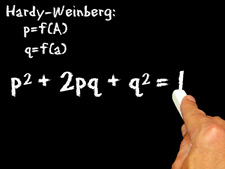Home | Glossary | Resources | Help | Contact Us | Course Map
Archival Notice
This is an archive page that is no longer being updated. It may contain outdated information and links may no longer function as originally intended.
The product rule is used to estimate the chance of finding a given STR profile within a population. This is done by multiplying the frequency of each of the genotypes (combination of alleles) found at all loci in the STR profile.
In the case of Y-chromosome STRs and mitochondrial DNA (mtDNA) the product rule can not be used. For more information on Y-STRs and mtDNA, refer to Module 8.
The product rule requires using formulas defined by "Hardy-Weinberg Equilibrium," which predicts the probability of observing a particular homozygote (same allele inherited from each parent) profile or a heterozygote (different allele inherited from each parent) profile in a population.
Additional Online Courses
- What Every First Responding Officer Should Know About DNA Evidence
- Collecting DNA Evidence at Property Crime Scenes
- DNA – A Prosecutor’s Practice Notebook
- Crime Scene and DNA Basics
- Laboratory Safety Programs
- DNA Amplification
- Population Genetics and Statistics
- Non-STR DNA Markers: SNPs, Y-STRs, LCN and mtDNA
- Firearms Examiner Training
- Forensic DNA Education for Law Enforcement Decisionmakers
- What Every Investigator and Evidence Technician Should Know About DNA Evidence
- Principles of Forensic DNA for Officers of the Court
- Law 101: Legal Guide for the Forensic Expert
- Laboratory Orientation and Testing of Body Fluids and Tissues
- DNA Extraction and Quantitation
- STR Data Analysis and Interpretation
- Communication Skills, Report Writing, and Courtroom Testimony
- Español for Law Enforcement
- Amplified DNA Product Separation for Forensic Analysts


